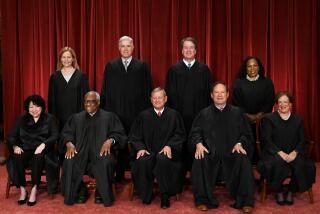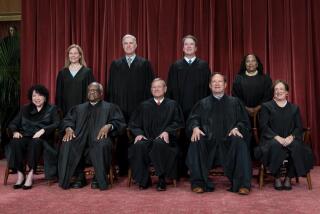Former Supreme Court Justice David H. Souter dies at 85

- Share via
- Souter played a crucial role in upholding a woman’s right to choose abortion in 1992.
- Repealing the constitutional right to abortion would be “a surrender to political pressure,” he wrote.
WASHINGTON — Retired Supreme Court Justice David H. Souter, the shy and frugal small-town New Englander who was touted as a conservative but surprised his Republican backers and nearly everyone else by becoming a staunch liberal on the high court, has died, the court said in a statement Friday. He was 85.
Souter stepped down in 2009 after nearly two decades on the court where he cast key votes to uphold laws on campaign finance, environmental protection, civil rights and church-state separation. He also played a crucial role in upholding a woman’s right to choose abortion in 1992.
Chief Justice John G. Roberts said in a statement that “Justice Souter served our court with great distinction for nearly 20 years. He brought uncommon wisdom and kindness to a lifetime of public service.”
Souter often said he liked the court work, but he did not like living in Washington and looked forward to returning home.
“After retiring to his beloved New Hampshire in 2009, he continued to render significant service to our branch by sitting regularly on the court of appeals for the First Circuit,” Roberts said.

As an appointee of President George H.W. Bush, Souter was expected to join with then-Chief Justice William H. Rehnquist and other conservatives who were determined to overturn Roe v. Wade, the landmark 1973 decision that expanded abortion rights.
President Bush on Monday chose David Hackett Souter, a little-known judge from New Hampshire, to be an associate justice of the U.S.
But when a Pennsylvania test case came before the court in 1992, Souter instead joined moderate Justices Sandra Day O’Connor and Anthony M. Kennedy to affirm the right to abortion. Souter saw the issue as a matter of precedent.
Repealing the constitutional right to abortion would be “a surrender to political pressure,” he wrote. “To overrule under fire in the absence of the most compelling reason to re-examine a watershed decision would subvert the Court’s legitimacy beyond any serious question.”
That decision stood for 30 years, but in 2022, three new justices appointed by President Trump played key roles in overturning the constitutional right to abortion and leaving it to the states to decide.
Souter had also cast key votes to maintain church-state separation. In 1992, he joined a 5-4 decision that upheld the strict ban on school-sponsored prayers at graduations. The five justices who voted to uphold the abortion right and the ban on school prayers were all Republican appointees.
But they no longer reflected the views of a more socially conservative GOP, and Souter was denounced by some in the party as a turn-coat. By the late 1990s, “No more Souters” had become a rallying cry for conservative legal activists.
“Justice Souter was a judicial version of a disappearing phenomenon: the moderate New England Republican,” said Pamela Karlan, a professor at Stanford Law School. “He was not a true liberal and would not have been a liberal on the court of the 1960s and ‘70s. But he believed in privacy and civil rights and precedents, and that made him a liberal on the court of his day.”

He was unusual in other ways. Shortly after he arrived as a new justice in 1990, he was dubbed one of the city’s “most eligible bachelors” in the Washington Post, leading to a series of dinner invitations. He usually found himself seated between a single woman and a guest who spoke only Japanese, he later joked.
Souter became adept at turning down invitations. He would dine with Justice John Paul Stevens and his wife, or with O’Connor, but mostly he worked and ate alone. He spent evenings jogging along the waterfront near his small apartment.
Whenever the court took an extended break, Souter drove to the farmhouse where he grew up in tiny Weare, N.H., so he could hike.
He was in good health and not yet 70 when President Obama moved into the White House in early 2009. Soon after, Souter passed word that he intended to retire. Obama chose Judge Sonia Sotomayor, the first Latina on the high court, to replace him.
Souter was dubbed a “stealth nominee” when he arrived in Washington in 1990, and he remained a mystery when he left. He did no interviews and made no public statements.
Back in New Hampshire, he continued to serve part time as a retired judge on the 1st Circuit Court of Appeals in Boston, deciding low-profile cases out of the public spotlight.
Souter was not the first justice to surprise the president who appointed him, but he may be among the last. Since Souter’s time — and indeed, partly in reaction to him — presidents have carefully selected court nominees with public records showing they shared similar views on legal issues.

Souter had deep ties to the Republican Party. He carried a gold watch that was a prized possession of a great-great-grandfather who attended the Republican party convention of 1860 that nominated Abraham Lincoln as president.
The GOP supported environmental conservation and the separation of church and state when Souter was growing up. But it grew increasingly more conservative over the decades, and Souter didn’t always agree.
In July 1990, he was a 50-year-old bachelor who lived alone in a farm house with peeling paint and books on the floor. He had just been named to the U.S. court of appeals in Boston. Until then, he had spent his entire career as a prosecutor, state attorney and judge in New Hampshire.
His scholarly manner and devotion to the law had won him influential admirers, including then-Sen. Warren Rudman and former New Hampshire Gov. John Sununu, who was then-White House chief of staff to the first President Bush.
When the Supreme Court’s liberal leader, William J. Brennan, suffered a stroke and announced his retirement, Souter’s name made the president’s short list of possible nominees.
Bush was anxious to avoid a fight with Senate Democrats over abortion and civil rights. Republicans still smarted from the Senate’s defeat in 1987 of Judge Robert Bork, whose strongly conservative writings convinced critics he was too extreme to be confirmed.

Souter seemed an ideal nominee. He was conservative, or at least old-fashioned. He wrote with a fountain pen, not a computer. And he ignored television. He only learned Brennan was stepping down when a postal clerk in his town shared the news.
Two days later, Souter stood in the White House press room as Bush announced his nomination. Souter was said to have no “paper trail,” but Sununu privately assured activists that he would be a “home run for conservatives.”
Liberal Democrats, led by Sen. Edward Kennedy of Massachusetts, were Souter’s sharpest critics that summer, while the arch-conservative Sen. Strom Thurmond of South Carolina led the fight to confirm him. In less than two years, it became clear that both sides had miscalculated.
This article was originally on a blog post platform and may be missing photos, graphics or links.
By the mid-1990s, Souter had allied himself with Stevens, another moderate Republican who also seemed to move left, and with Justices Ruth Bader Ginsburg and Stephen G. Breyer, the two appointees of President Clinton. They formed a liberal bloc in cases where the court split along ideological lines.
David Hackett Souter was born in Melrose, Mass., on Sept. 17, 1939, the only child of Joseph and Helen Souter. His father was a banker and his mother a gift shop clerk. When he was 11, the family moved to the New Hampshire farm house in Weare that remained Souter’s primary home until after his retirement.
As a Harvard undergraduate, Souter dated a young woman and spoke of marrying her. But when he won a prestigious Rhodes Scholarship and went to England to study at Oxford University, she found someone else.
Souter told friends he was disappointed he never married. After graduating from Harvard Law School in 1966, he eschewed the big-city law firms and returned to the small-town life and rugged mountains of the New Hampshire he loved.
Friends and former clerks say Souter was never a true conservative as his early backers said, nor was he a solid liberal as he was portrayed years later.
Souter was “a judge’s judge,” said Penn Law professor Kermit Roosevelt, who clerked for him in 1999. “He didn’t have a political agenda. People had a mistaken idea of what they were getting when he was appointed.”
More to Read
Start your day right
Sign up for Essential California for the L.A. Times biggest news, features and recommendations in your inbox six days a week.
You may occasionally receive promotional content from the Los Angeles Times.







